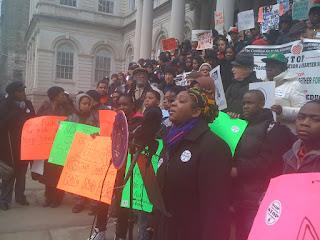

In his
latest NY Times column, Bob Herbert has shown that he belongs to the Nick Kristof club of "journalists" who helicopter into an issue, traipse around for a few hours, get treated like royalty and receive a king's tour, hear a one-sided pitch, watch a show being put on for their benefit, and then go write a story as if they actually know something about the broader topic.
Herbert decided to dabble for a few hours in NYC public school education, and the Potemkin village story he presents is about the marvels of
Harlem Village Academy (HVA) charter school on West 144th Street. Herbert makes much of one his one selected statistic:
"In 2008, when the math and science test scores come in, Ms. Kenny's eighth graders had achieved 100 percent proficiency." That's commendable, of course, but here are
a few figures he overlooked or failed to mention:
-- In 2006-07, the first year on which DOE reports data for HVA, the school had a Grade 5 class of 66 students. HVA has no students in Grades K-4, so Grade 5 appears to be the school's primary intake class. The next year, that same cohort as Grade 6 students numbered 45. A 32% loss of students in a single year for such a stellar school, even in the middle school crossover year, is worth explaining.
-- In 2006-07, HVA had a Grade 7 class of 42 students, but the next year's Grade 8 cohort numbered just 31, another 26% loss of students that raises an eyebrow or two.
-- One-third of the school's classes in 2008 were "taught by teachers without appropriate certification" according to the DOE's own data, and 42% of the teachers were reported either without certification (18%) or teaching outside their area of certification (24%). HVA did not report its teacher turnover rates for the DOE's 2007-08 report, nor does it appear to have ever disclosed those figures for the DOE's public reporting.
-- In 2006-07, HVA had zero students out of 200 classified at Limited English Proficient (LEP); in 2007-08, that number was still only three out of 233. By comparison, PS/IS 210, located just eight blocks away on West 152nd Street, had 173 LEP students out of a student population of 360 in 2007-08, or 48%.
-- In 2006-07, 53% of the HVA student body qualified for free lunch, rising to 61% in 2007-08. By comparison, 91% of the student population at nearby PS/IS 210 qualified for free lunch in 2006-07 (no data reported for 2007-08).
-- HVA reported 75 student suspensions in 2005-06 and 87 suspensions for 2006-07. The student body in those two years totaled 200 and 233, respectively. Nearby PS/IS 210 reported just 10 suspensions in each of those two years for student populations of 192 and 257, respectively. Both schools reported 94% attendance rates for 2006-07, the only year reported by HVA.
-- For 2007-08, HVA reported a Grade 8 cohort of 31 students. Thirty took the Grade 8 Math exam, but only 25 took the Grade 8 Science exam in which 96% were rated Proficient. What happened to the other six students, almost 20% of the class? If they were all too weak academically to have reached Proficient, the school's percentage would have dropped to 77% -- still good, but not as chest-thumping as 96%. Curiously, 41 of HVA's 43 Grade 8 student the previous year took the Science exam for 2006-07, and their proficiency percentage came in just there, at 76%.
-- A recent
executive search letter seeking teachers on HVA's behalf included the following statement:
The organization [Harlem Village Academies]
recently completed a $67 million capital campaign to build a new high school in the heart of Harlem and has a robust pipeline of donors. Harlem Village Academies recently held its first ever gala, hosted by Hugh Jackman, with performances by John Legend, Patti LaBelle, and Joss Stone. The event, attended by Mayor Bloomber and Governor Patterson, generated net revenues of nearly $2 million. I can't resist adding here that the DOE is still aggressively pursuing its edict that NYC public school students are forbidden from selling homemade brownies, cupcakes, or cookies to raise $50 or $100 for their clubs and activities; if they could just get Hugh Jackman and Patti LaBelle!
--
Other recent news items from HVA's own website cite the involvement of Jack Welch (GE), Dick Parsons (Citigroup), Brian Williams (NBC), and Tiki Barber. Again, compare all this to the (steadily shrinking) resources DOE provides to PS/IS 210 and its much needier student population nearby. Note as well that Mayor Bloomberg is repeatedly quoted in the school's literature and on its website as describing HVA as "the poster child for this country."
Is this really the Mayor's vision for NYC public schools: dependent on celebrities and the feel-good charitable funding fad of the moment among NYC's corporatocracy and its nouveau riche hedge fund managers?-- Principal Deborah Kenny, as chief executive of Harlem Village Network (which includes one other school in East Harlem, the Leadership Village Academy Charter School), commanded a neat little
compensation package totaling slightly under $420,000 last year. She is not the acting principal of any of her network's three schools, yet her compensation, spread over the 400-odd students in her network, adds a $1,000 per student overhead burden.
If the entire NYC public school system operated in the same manner for its one million students, the combined compensation for all the comparable "network chief executives" would add one billion dollars to the city's education budget! I should state here that I am not categorically opposed to charter schools in principle, any more than I have ever been opposed to parochial schools (from which, in Indianapolis, I am a partial product). What I object to is the unthinking, unquestioning acceptance by people like Mr. Herbert, who are supposed to know better, that privatizing public education based on hidden investors (with potentially their own agendas), paying outsized salaries to members of the club, dumping at will any kids who are difficult to teach or control, ignoring kids with English language or special education needs, and then blindly comparing these cream-skimmed apples to a wholly different and far more inclusive set of underfunded oranges somehow represents "the answer" for urban education in America. Mr. Herbert owes us much better than the misleading storyline he has provided in this instance, whatever his personal feelings and connections are.
Schools like Harlem Village Academy may indeed work well for the population they create for themselves after dumping the kids they don't want back into the "traditional" public school system, and they deserve to be credited for what they achieve as a result since their students appear to be benefiting. But that's not public education, that's just a tuition-free private school operating on public money in public space, supplemented by lots and lots of private money and making a few more, mostly white people like Ms. Kenny and Ms. Moskowitz shamefully well-paid.
 of wasteful spending.
of wasteful spending. Eva has now extended the reach of her mailings into large swathes of Manhattan and the Bronx. As one astute observer pointed out, this not only allows her to build up her charter school waiting list, but also to gather names for future battles over the charter school cap, funding, or her own future candidacy.
Eva has now extended the reach of her mailings into large swathes of Manhattan and the Bronx. As one astute observer pointed out, this not only allows her to build up her charter school waiting list, but also to gather names for future battles over the charter school cap, funding, or her own future candidacy.












